Analysis and Evaluation of Public Programs: Drug Prevention in Schools
VerifiedAdded on 2021/09/18
|11
|2656
|70
Report
AI Summary
This report provides an analysis and evaluation of public programs, specifically focusing on drug prevention initiatives in US schools, referencing the article by Cho et al. (2009). The report examines the influence of the No Child Left Behind legislation and the Safe and Drug-Free Schools (SDFS) program on drug prevention efforts. It discusses the evaluation of program effectiveness, theoretical perspectives, and research methods used in the study. The report highlights the challenges in implementing evidence-based curricula and the disparities in funding and prioritization between state and local agencies. It also explores the use of process evaluation, qualitative and quantitative research methods, and cost-benefit analysis in assessing the program's impact. The findings suggest that the No Child Left Behind policies had a minimal influence on drug prevention practices due to funding barriers and disparities, which can be useful for the education department to re-focus on the local district schools. The report concludes by recommending that all the schools be prioritized without any sense of discrimination.
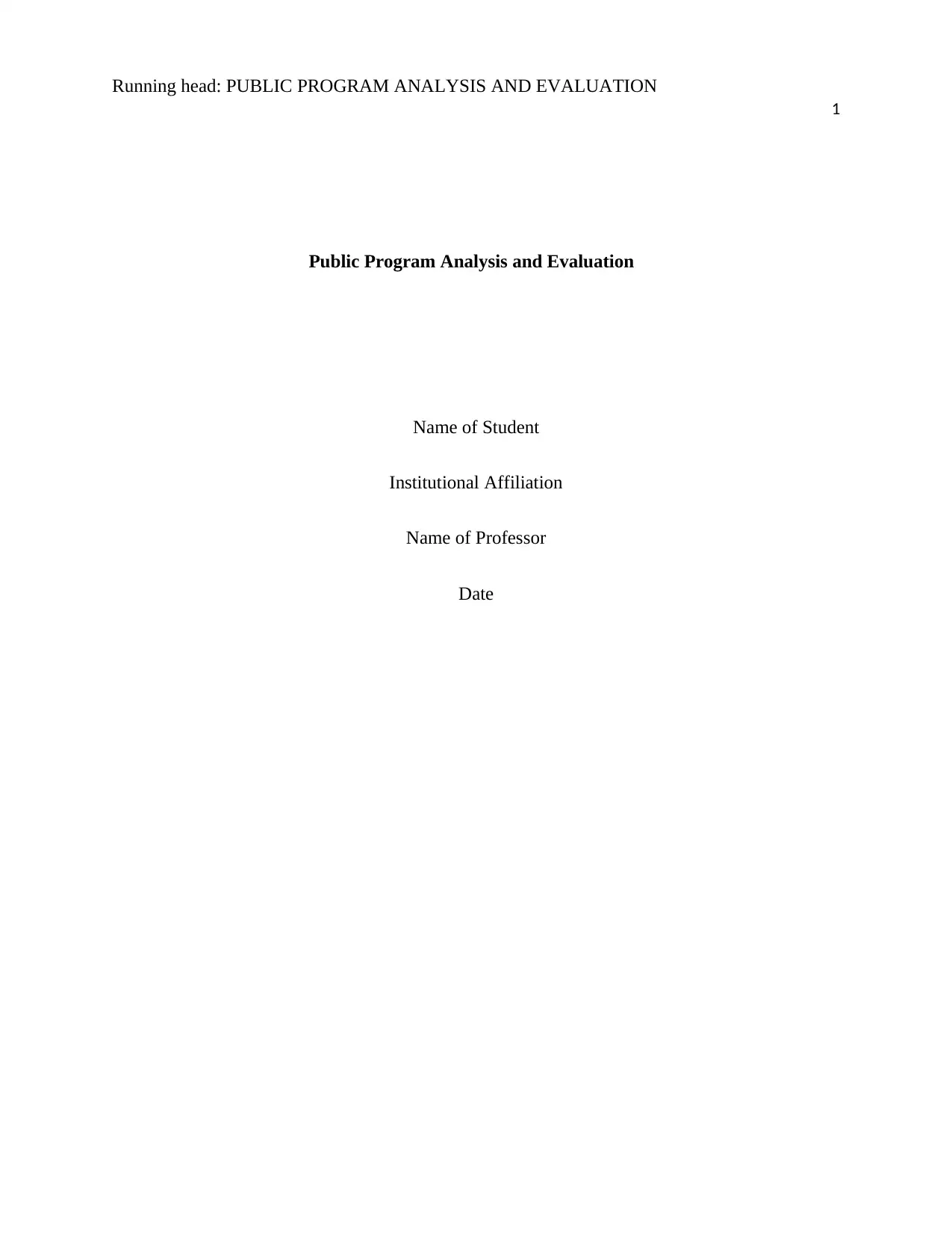
Running head: PUBLIC PROGRAM ANALYSIS AND EVALUATION
1
Public Program Analysis and Evaluation
Name of Student
Institutional Affiliation
Name of Professor
Date
1
Public Program Analysis and Evaluation
Name of Student
Institutional Affiliation
Name of Professor
Date
Secure Best Marks with AI Grader
Need help grading? Try our AI Grader for instant feedback on your assignments.
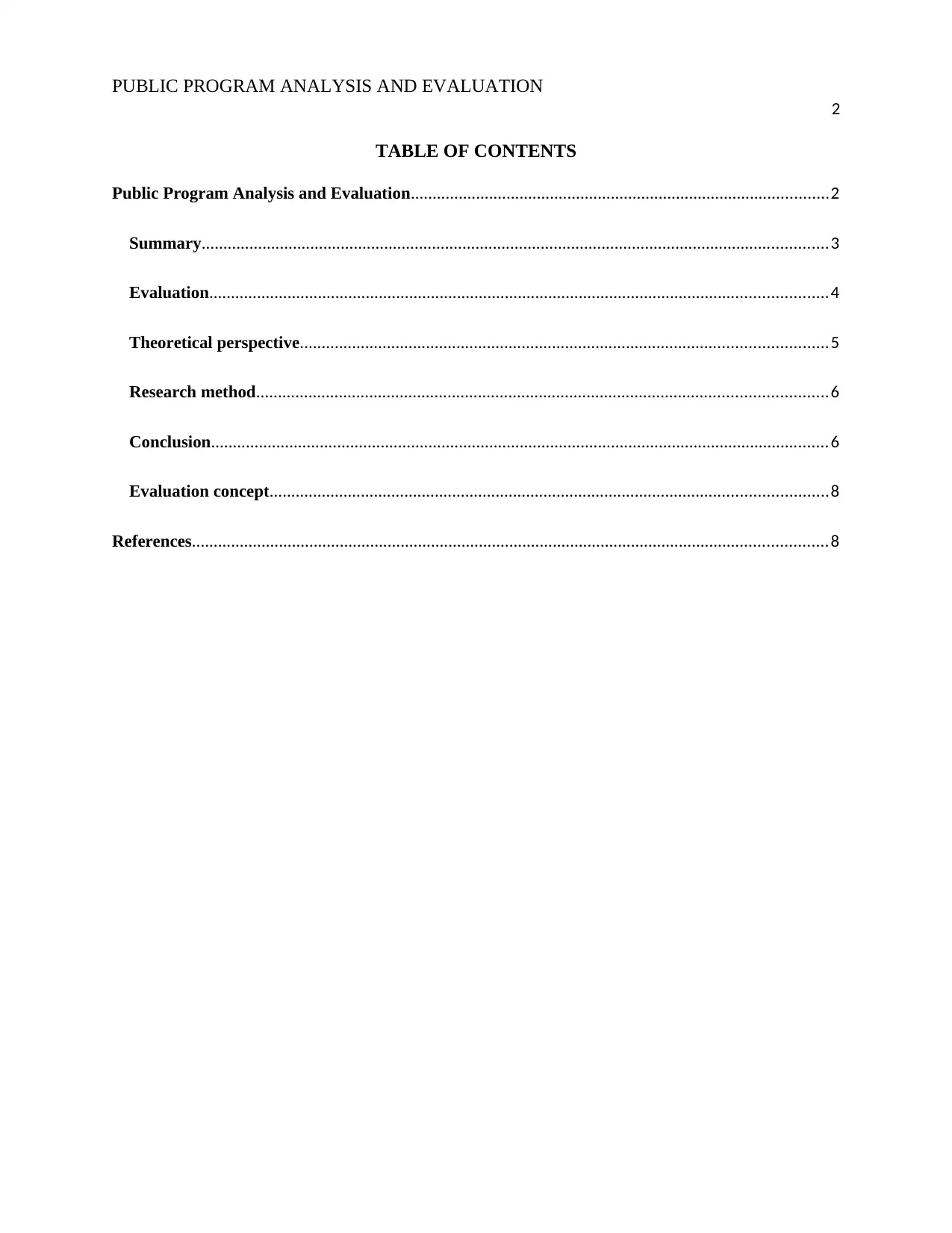
PUBLIC PROGRAM ANALYSIS AND EVALUATION
2
TABLE OF CONTENTS
Public Program Analysis and Evaluation................................................................................................2
Summary................................................................................................................................................3
Evaluation..............................................................................................................................................4
Theoretical perspective.........................................................................................................................5
Research method...................................................................................................................................6
Conclusion..............................................................................................................................................6
Evaluation concept................................................................................................................................8
References..................................................................................................................................................8
2
TABLE OF CONTENTS
Public Program Analysis and Evaluation................................................................................................2
Summary................................................................................................................................................3
Evaluation..............................................................................................................................................4
Theoretical perspective.........................................................................................................................5
Research method...................................................................................................................................6
Conclusion..............................................................................................................................................6
Evaluation concept................................................................................................................................8
References..................................................................................................................................................8
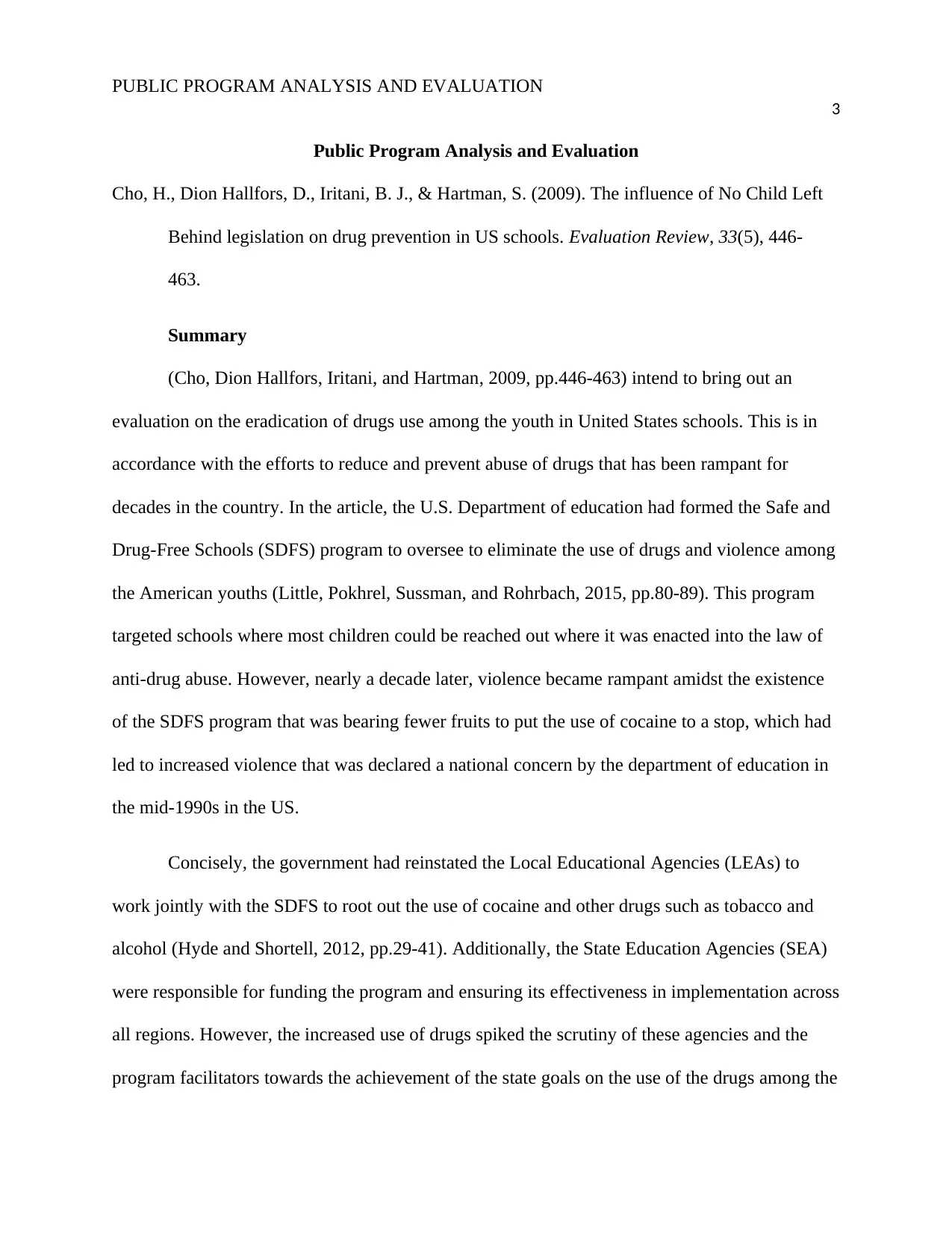
PUBLIC PROGRAM ANALYSIS AND EVALUATION
3
Public Program Analysis and Evaluation
Cho, H., Dion Hallfors, D., Iritani, B. J., & Hartman, S. (2009). The influence of No Child Left
Behind legislation on drug prevention in US schools. Evaluation Review, 33(5), 446-
463.
Summary
(Cho, Dion Hallfors, Iritani, and Hartman, 2009, pp.446-463) intend to bring out an
evaluation on the eradication of drugs use among the youth in United States schools. This is in
accordance with the efforts to reduce and prevent abuse of drugs that has been rampant for
decades in the country. In the article, the U.S. Department of education had formed the Safe and
Drug-Free Schools (SDFS) program to oversee to eliminate the use of drugs and violence among
the American youths (Little, Pokhrel, Sussman, and Rohrbach, 2015, pp.80-89). This program
targeted schools where most children could be reached out where it was enacted into the law of
anti-drug abuse. However, nearly a decade later, violence became rampant amidst the existence
of the SDFS program that was bearing fewer fruits to put the use of cocaine to a stop, which had
led to increased violence that was declared a national concern by the department of education in
the mid-1990s in the US.
Concisely, the government had reinstated the Local Educational Agencies (LEAs) to
work jointly with the SDFS to root out the use of cocaine and other drugs such as tobacco and
alcohol (Hyde and Shortell, 2012, pp.29-41). Additionally, the State Education Agencies (SEA)
were responsible for funding the program and ensuring its effectiveness in implementation across
all regions. However, the increased use of drugs spiked the scrutiny of these agencies and the
program facilitators towards the achievement of the state goals on the use of the drugs among the
3
Public Program Analysis and Evaluation
Cho, H., Dion Hallfors, D., Iritani, B. J., & Hartman, S. (2009). The influence of No Child Left
Behind legislation on drug prevention in US schools. Evaluation Review, 33(5), 446-
463.
Summary
(Cho, Dion Hallfors, Iritani, and Hartman, 2009, pp.446-463) intend to bring out an
evaluation on the eradication of drugs use among the youth in United States schools. This is in
accordance with the efforts to reduce and prevent abuse of drugs that has been rampant for
decades in the country. In the article, the U.S. Department of education had formed the Safe and
Drug-Free Schools (SDFS) program to oversee to eliminate the use of drugs and violence among
the American youths (Little, Pokhrel, Sussman, and Rohrbach, 2015, pp.80-89). This program
targeted schools where most children could be reached out where it was enacted into the law of
anti-drug abuse. However, nearly a decade later, violence became rampant amidst the existence
of the SDFS program that was bearing fewer fruits to put the use of cocaine to a stop, which had
led to increased violence that was declared a national concern by the department of education in
the mid-1990s in the US.
Concisely, the government had reinstated the Local Educational Agencies (LEAs) to
work jointly with the SDFS to root out the use of cocaine and other drugs such as tobacco and
alcohol (Hyde and Shortell, 2012, pp.29-41). Additionally, the State Education Agencies (SEA)
were responsible for funding the program and ensuring its effectiveness in implementation across
all regions. However, the increased use of drugs spiked the scrutiny of these agencies and the
program facilitators towards the achievement of the state goals on the use of the drugs among the
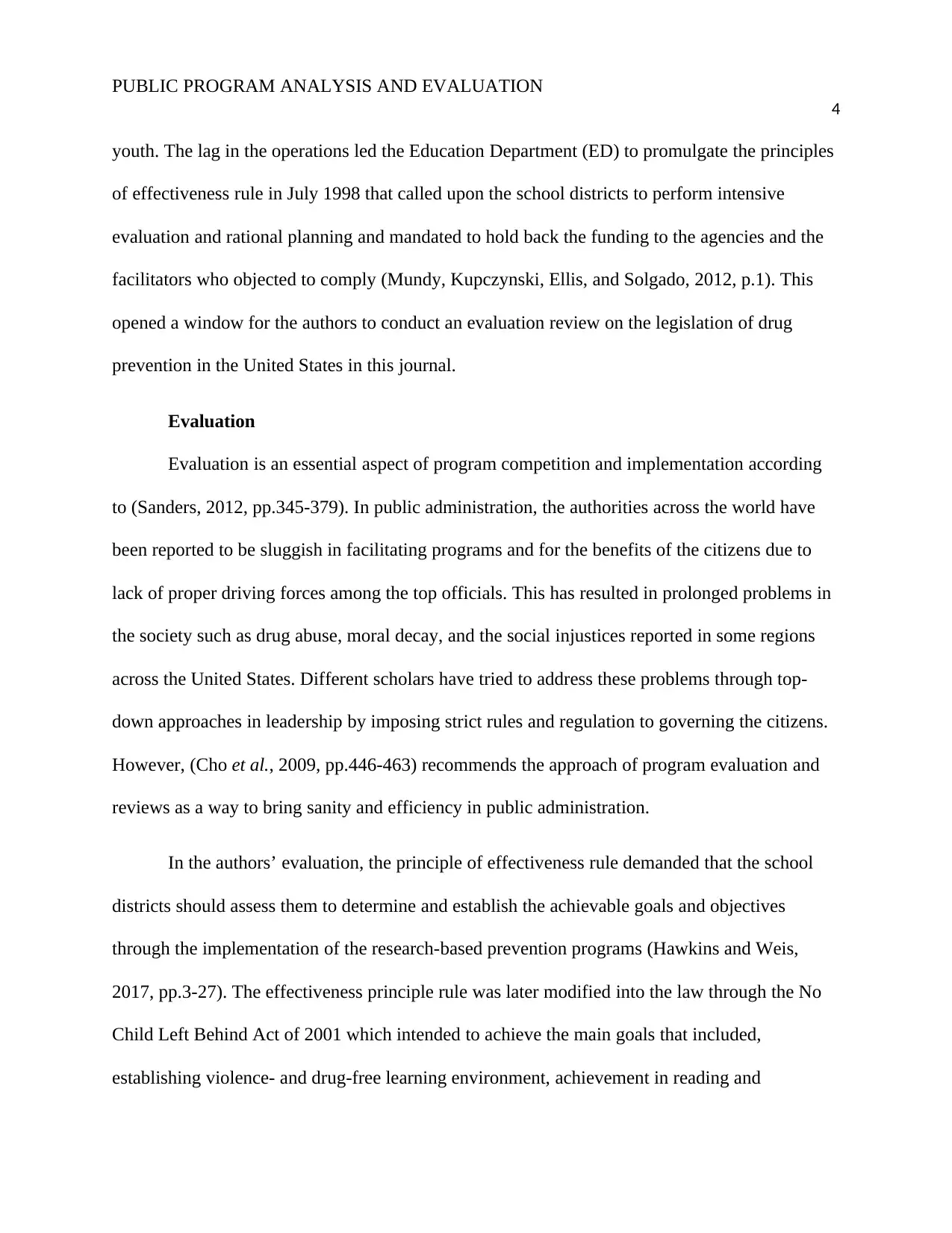
PUBLIC PROGRAM ANALYSIS AND EVALUATION
4
youth. The lag in the operations led the Education Department (ED) to promulgate the principles
of effectiveness rule in July 1998 that called upon the school districts to perform intensive
evaluation and rational planning and mandated to hold back the funding to the agencies and the
facilitators who objected to comply (Mundy, Kupczynski, Ellis, and Solgado, 2012, p.1). This
opened a window for the authors to conduct an evaluation review on the legislation of drug
prevention in the United States in this journal.
Evaluation
Evaluation is an essential aspect of program competition and implementation according
to (Sanders, 2012, pp.345-379). In public administration, the authorities across the world have
been reported to be sluggish in facilitating programs and for the benefits of the citizens due to
lack of proper driving forces among the top officials. This has resulted in prolonged problems in
the society such as drug abuse, moral decay, and the social injustices reported in some regions
across the United States. Different scholars have tried to address these problems through top-
down approaches in leadership by imposing strict rules and regulation to governing the citizens.
However, (Cho et al., 2009, pp.446-463) recommends the approach of program evaluation and
reviews as a way to bring sanity and efficiency in public administration.
In the authors’ evaluation, the principle of effectiveness rule demanded that the school
districts should assess them to determine and establish the achievable goals and objectives
through the implementation of the research-based prevention programs (Hawkins and Weis,
2017, pp.3-27). The effectiveness principle rule was later modified into the law through the No
Child Left Behind Act of 2001 which intended to achieve the main goals that included,
establishing violence- and drug-free learning environment, achievement in reading and
4
youth. The lag in the operations led the Education Department (ED) to promulgate the principles
of effectiveness rule in July 1998 that called upon the school districts to perform intensive
evaluation and rational planning and mandated to hold back the funding to the agencies and the
facilitators who objected to comply (Mundy, Kupczynski, Ellis, and Solgado, 2012, p.1). This
opened a window for the authors to conduct an evaluation review on the legislation of drug
prevention in the United States in this journal.
Evaluation
Evaluation is an essential aspect of program competition and implementation according
to (Sanders, 2012, pp.345-379). In public administration, the authorities across the world have
been reported to be sluggish in facilitating programs and for the benefits of the citizens due to
lack of proper driving forces among the top officials. This has resulted in prolonged problems in
the society such as drug abuse, moral decay, and the social injustices reported in some regions
across the United States. Different scholars have tried to address these problems through top-
down approaches in leadership by imposing strict rules and regulation to governing the citizens.
However, (Cho et al., 2009, pp.446-463) recommends the approach of program evaluation and
reviews as a way to bring sanity and efficiency in public administration.
In the authors’ evaluation, the principle of effectiveness rule demanded that the school
districts should assess them to determine and establish the achievable goals and objectives
through the implementation of the research-based prevention programs (Hawkins and Weis,
2017, pp.3-27). The effectiveness principle rule was later modified into the law through the No
Child Left Behind Act of 2001 which intended to achieve the main goals that included,
establishing violence- and drug-free learning environment, achievement in reading and
Secure Best Marks with AI Grader
Need help grading? Try our AI Grader for instant feedback on your assignments.
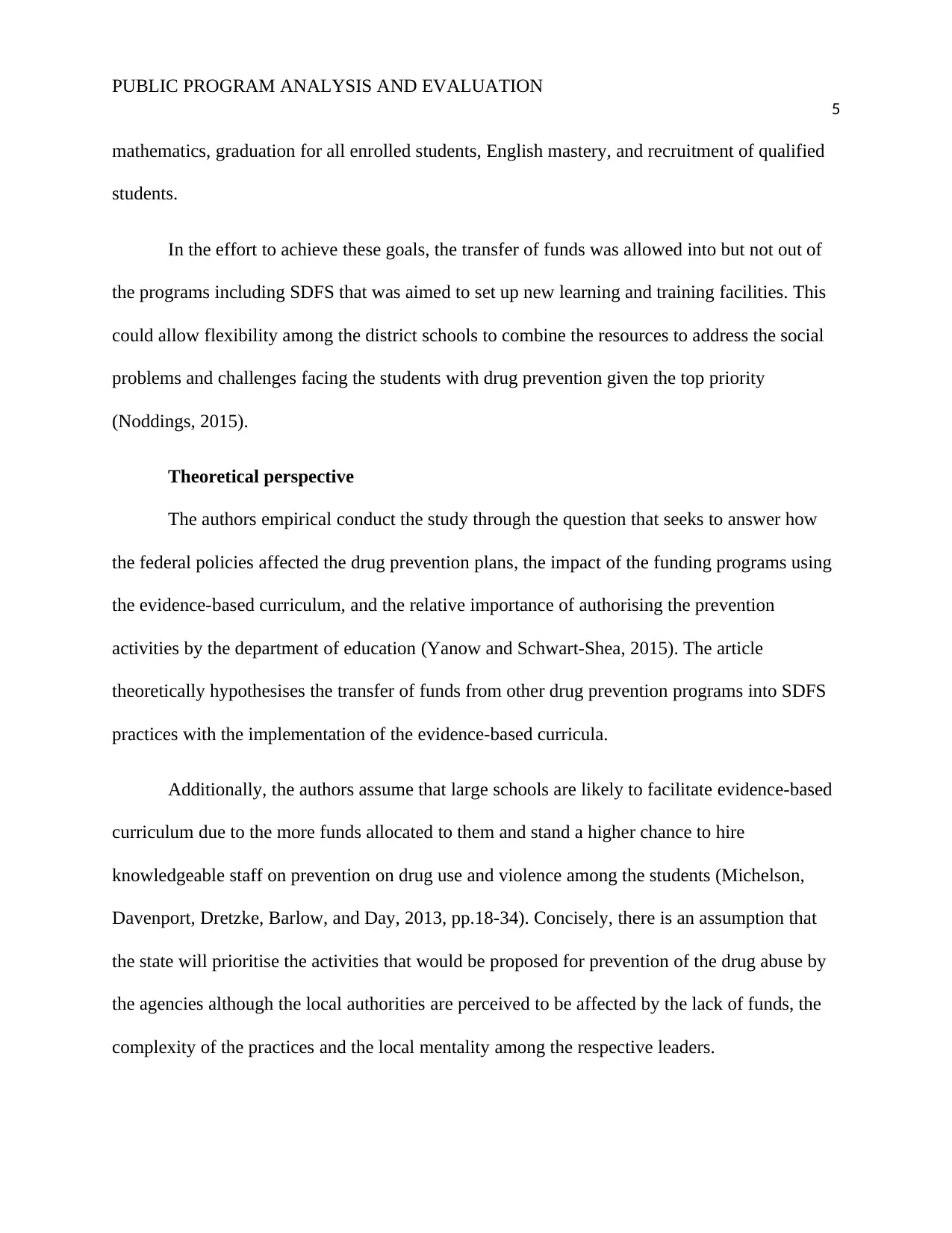
PUBLIC PROGRAM ANALYSIS AND EVALUATION
5
mathematics, graduation for all enrolled students, English mastery, and recruitment of qualified
students.
In the effort to achieve these goals, the transfer of funds was allowed into but not out of
the programs including SDFS that was aimed to set up new learning and training facilities. This
could allow flexibility among the district schools to combine the resources to address the social
problems and challenges facing the students with drug prevention given the top priority
(Noddings, 2015).
Theoretical perspective
The authors empirical conduct the study through the question that seeks to answer how
the federal policies affected the drug prevention plans, the impact of the funding programs using
the evidence-based curriculum, and the relative importance of authorising the prevention
activities by the department of education (Yanow and Schwart-Shea, 2015). The article
theoretically hypothesises the transfer of funds from other drug prevention programs into SDFS
practices with the implementation of the evidence-based curricula.
Additionally, the authors assume that large schools are likely to facilitate evidence-based
curriculum due to the more funds allocated to them and stand a higher chance to hire
knowledgeable staff on prevention on drug use and violence among the students (Michelson,
Davenport, Dretzke, Barlow, and Day, 2013, pp.18-34). Concisely, there is an assumption that
the state will prioritise the activities that would be proposed for prevention of the drug abuse by
the agencies although the local authorities are perceived to be affected by the lack of funds, the
complexity of the practices and the local mentality among the respective leaders.
5
mathematics, graduation for all enrolled students, English mastery, and recruitment of qualified
students.
In the effort to achieve these goals, the transfer of funds was allowed into but not out of
the programs including SDFS that was aimed to set up new learning and training facilities. This
could allow flexibility among the district schools to combine the resources to address the social
problems and challenges facing the students with drug prevention given the top priority
(Noddings, 2015).
Theoretical perspective
The authors empirical conduct the study through the question that seeks to answer how
the federal policies affected the drug prevention plans, the impact of the funding programs using
the evidence-based curriculum, and the relative importance of authorising the prevention
activities by the department of education (Yanow and Schwart-Shea, 2015). The article
theoretically hypothesises the transfer of funds from other drug prevention programs into SDFS
practices with the implementation of the evidence-based curricula.
Additionally, the authors assume that large schools are likely to facilitate evidence-based
curriculum due to the more funds allocated to them and stand a higher chance to hire
knowledgeable staff on prevention on drug use and violence among the students (Michelson,
Davenport, Dretzke, Barlow, and Day, 2013, pp.18-34). Concisely, there is an assumption that
the state will prioritise the activities that would be proposed for prevention of the drug abuse by
the agencies although the local authorities are perceived to be affected by the lack of funds, the
complexity of the practices and the local mentality among the respective leaders.
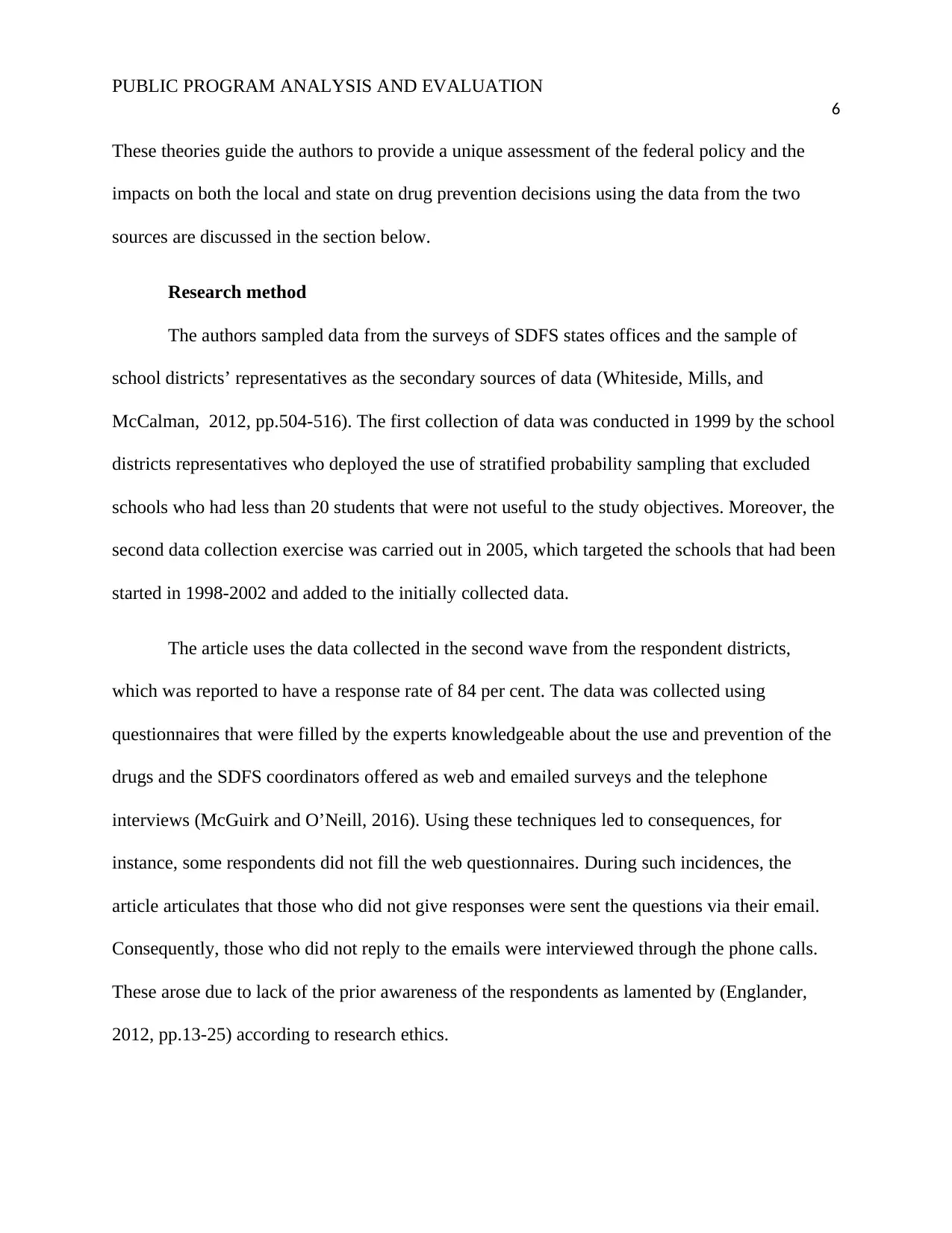
PUBLIC PROGRAM ANALYSIS AND EVALUATION
6
These theories guide the authors to provide a unique assessment of the federal policy and the
impacts on both the local and state on drug prevention decisions using the data from the two
sources are discussed in the section below.
Research method
The authors sampled data from the surveys of SDFS states offices and the sample of
school districts’ representatives as the secondary sources of data (Whiteside, Mills, and
McCalman, 2012, pp.504-516). The first collection of data was conducted in 1999 by the school
districts representatives who deployed the use of stratified probability sampling that excluded
schools who had less than 20 students that were not useful to the study objectives. Moreover, the
second data collection exercise was carried out in 2005, which targeted the schools that had been
started in 1998-2002 and added to the initially collected data.
The article uses the data collected in the second wave from the respondent districts,
which was reported to have a response rate of 84 per cent. The data was collected using
questionnaires that were filled by the experts knowledgeable about the use and prevention of the
drugs and the SDFS coordinators offered as web and emailed surveys and the telephone
interviews (McGuirk and O’Neill, 2016). Using these techniques led to consequences, for
instance, some respondents did not fill the web questionnaires. During such incidences, the
article articulates that those who did not give responses were sent the questions via their email.
Consequently, those who did not reply to the emails were interviewed through the phone calls.
These arose due to lack of the prior awareness of the respondents as lamented by (Englander,
2012, pp.13-25) according to research ethics.
6
These theories guide the authors to provide a unique assessment of the federal policy and the
impacts on both the local and state on drug prevention decisions using the data from the two
sources are discussed in the section below.
Research method
The authors sampled data from the surveys of SDFS states offices and the sample of
school districts’ representatives as the secondary sources of data (Whiteside, Mills, and
McCalman, 2012, pp.504-516). The first collection of data was conducted in 1999 by the school
districts representatives who deployed the use of stratified probability sampling that excluded
schools who had less than 20 students that were not useful to the study objectives. Moreover, the
second data collection exercise was carried out in 2005, which targeted the schools that had been
started in 1998-2002 and added to the initially collected data.
The article uses the data collected in the second wave from the respondent districts,
which was reported to have a response rate of 84 per cent. The data was collected using
questionnaires that were filled by the experts knowledgeable about the use and prevention of the
drugs and the SDFS coordinators offered as web and emailed surveys and the telephone
interviews (McGuirk and O’Neill, 2016). Using these techniques led to consequences, for
instance, some respondents did not fill the web questionnaires. During such incidences, the
article articulates that those who did not give responses were sent the questions via their email.
Consequently, those who did not reply to the emails were interviewed through the phone calls.
These arose due to lack of the prior awareness of the respondents as lamented by (Englander,
2012, pp.13-25) according to research ethics.
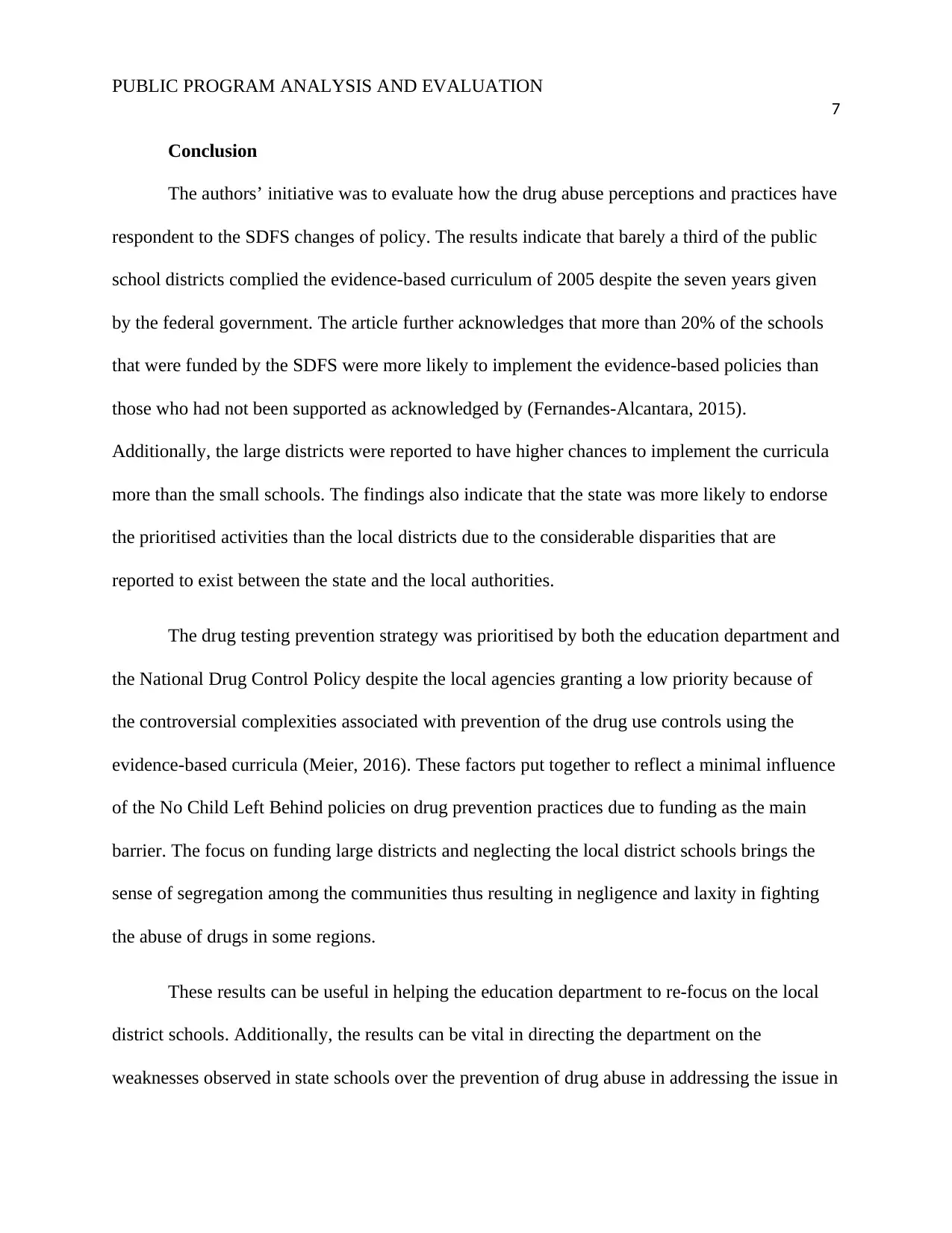
PUBLIC PROGRAM ANALYSIS AND EVALUATION
7
Conclusion
The authors’ initiative was to evaluate how the drug abuse perceptions and practices have
respondent to the SDFS changes of policy. The results indicate that barely a third of the public
school districts complied the evidence-based curriculum of 2005 despite the seven years given
by the federal government. The article further acknowledges that more than 20% of the schools
that were funded by the SDFS were more likely to implement the evidence-based policies than
those who had not been supported as acknowledged by (Fernandes-Alcantara, 2015).
Additionally, the large districts were reported to have higher chances to implement the curricula
more than the small schools. The findings also indicate that the state was more likely to endorse
the prioritised activities than the local districts due to the considerable disparities that are
reported to exist between the state and the local authorities.
The drug testing prevention strategy was prioritised by both the education department and
the National Drug Control Policy despite the local agencies granting a low priority because of
the controversial complexities associated with prevention of the drug use controls using the
evidence-based curricula (Meier, 2016). These factors put together to reflect a minimal influence
of the No Child Left Behind policies on drug prevention practices due to funding as the main
barrier. The focus on funding large districts and neglecting the local district schools brings the
sense of segregation among the communities thus resulting in negligence and laxity in fighting
the abuse of drugs in some regions.
These results can be useful in helping the education department to re-focus on the local
district schools. Additionally, the results can be vital in directing the department on the
weaknesses observed in state schools over the prevention of drug abuse in addressing the issue in
7
Conclusion
The authors’ initiative was to evaluate how the drug abuse perceptions and practices have
respondent to the SDFS changes of policy. The results indicate that barely a third of the public
school districts complied the evidence-based curriculum of 2005 despite the seven years given
by the federal government. The article further acknowledges that more than 20% of the schools
that were funded by the SDFS were more likely to implement the evidence-based policies than
those who had not been supported as acknowledged by (Fernandes-Alcantara, 2015).
Additionally, the large districts were reported to have higher chances to implement the curricula
more than the small schools. The findings also indicate that the state was more likely to endorse
the prioritised activities than the local districts due to the considerable disparities that are
reported to exist between the state and the local authorities.
The drug testing prevention strategy was prioritised by both the education department and
the National Drug Control Policy despite the local agencies granting a low priority because of
the controversial complexities associated with prevention of the drug use controls using the
evidence-based curricula (Meier, 2016). These factors put together to reflect a minimal influence
of the No Child Left Behind policies on drug prevention practices due to funding as the main
barrier. The focus on funding large districts and neglecting the local district schools brings the
sense of segregation among the communities thus resulting in negligence and laxity in fighting
the abuse of drugs in some regions.
These results can be useful in helping the education department to re-focus on the local
district schools. Additionally, the results can be vital in directing the department on the
weaknesses observed in state schools over the prevention of drug abuse in addressing the issue in
Paraphrase This Document
Need a fresh take? Get an instant paraphrase of this document with our AI Paraphraser
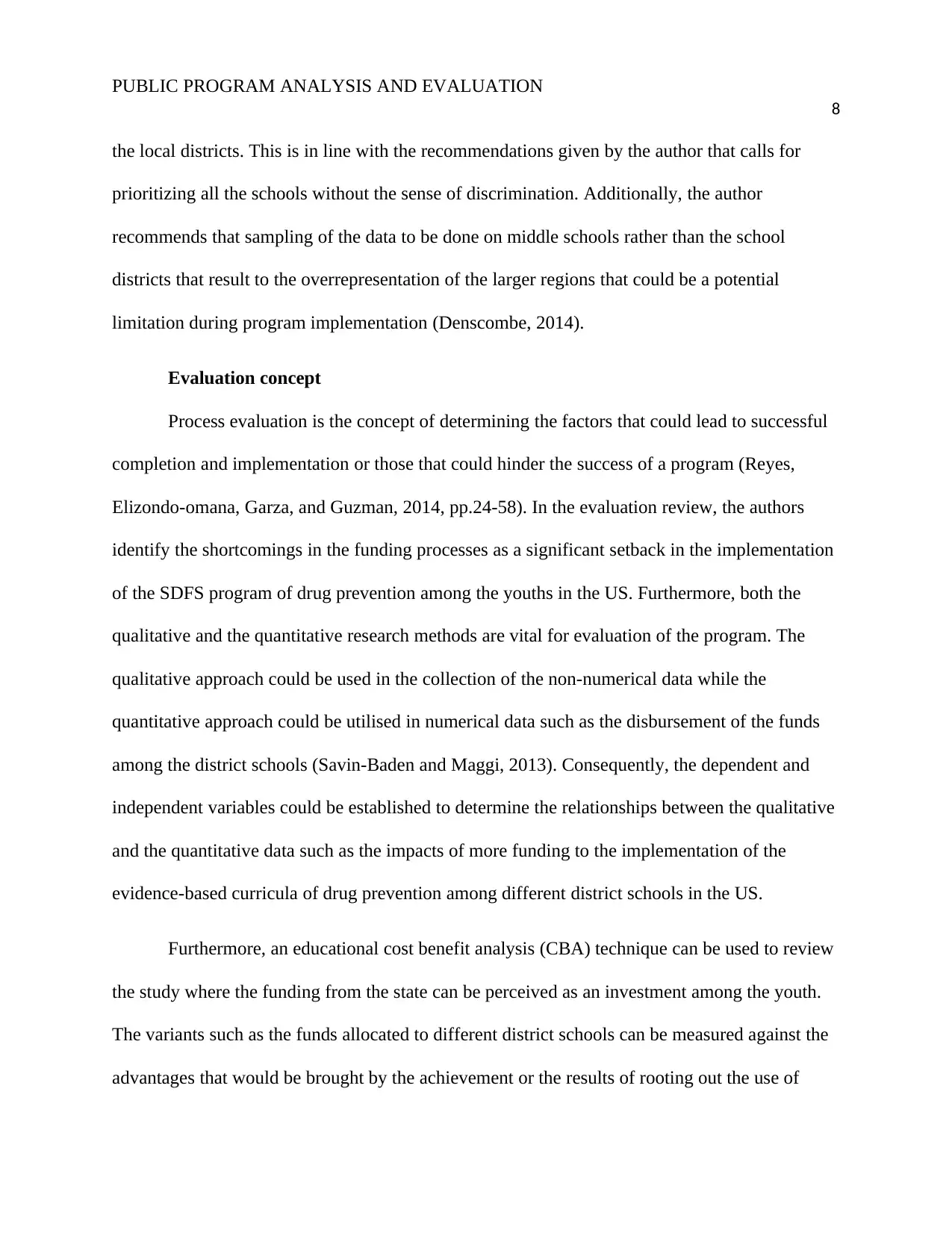
PUBLIC PROGRAM ANALYSIS AND EVALUATION
8
the local districts. This is in line with the recommendations given by the author that calls for
prioritizing all the schools without the sense of discrimination. Additionally, the author
recommends that sampling of the data to be done on middle schools rather than the school
districts that result to the overrepresentation of the larger regions that could be a potential
limitation during program implementation (Denscombe, 2014).
Evaluation concept
Process evaluation is the concept of determining the factors that could lead to successful
completion and implementation or those that could hinder the success of a program (Reyes,
Elizondo-omana, Garza, and Guzman, 2014, pp.24-58). In the evaluation review, the authors
identify the shortcomings in the funding processes as a significant setback in the implementation
of the SDFS program of drug prevention among the youths in the US. Furthermore, both the
qualitative and the quantitative research methods are vital for evaluation of the program. The
qualitative approach could be used in the collection of the non-numerical data while the
quantitative approach could be utilised in numerical data such as the disbursement of the funds
among the district schools (Savin-Baden and Maggi, 2013). Consequently, the dependent and
independent variables could be established to determine the relationships between the qualitative
and the quantitative data such as the impacts of more funding to the implementation of the
evidence-based curricula of drug prevention among different district schools in the US.
Furthermore, an educational cost benefit analysis (CBA) technique can be used to review
the study where the funding from the state can be perceived as an investment among the youth.
The variants such as the funds allocated to different district schools can be measured against the
advantages that would be brought by the achievement or the results of rooting out the use of
8
the local districts. This is in line with the recommendations given by the author that calls for
prioritizing all the schools without the sense of discrimination. Additionally, the author
recommends that sampling of the data to be done on middle schools rather than the school
districts that result to the overrepresentation of the larger regions that could be a potential
limitation during program implementation (Denscombe, 2014).
Evaluation concept
Process evaluation is the concept of determining the factors that could lead to successful
completion and implementation or those that could hinder the success of a program (Reyes,
Elizondo-omana, Garza, and Guzman, 2014, pp.24-58). In the evaluation review, the authors
identify the shortcomings in the funding processes as a significant setback in the implementation
of the SDFS program of drug prevention among the youths in the US. Furthermore, both the
qualitative and the quantitative research methods are vital for evaluation of the program. The
qualitative approach could be used in the collection of the non-numerical data while the
quantitative approach could be utilised in numerical data such as the disbursement of the funds
among the district schools (Savin-Baden and Maggi, 2013). Consequently, the dependent and
independent variables could be established to determine the relationships between the qualitative
and the quantitative data such as the impacts of more funding to the implementation of the
evidence-based curricula of drug prevention among different district schools in the US.
Furthermore, an educational cost benefit analysis (CBA) technique can be used to review
the study where the funding from the state can be perceived as an investment among the youth.
The variants such as the funds allocated to different district schools can be measured against the
advantages that would be brought by the achievement or the results of rooting out the use of
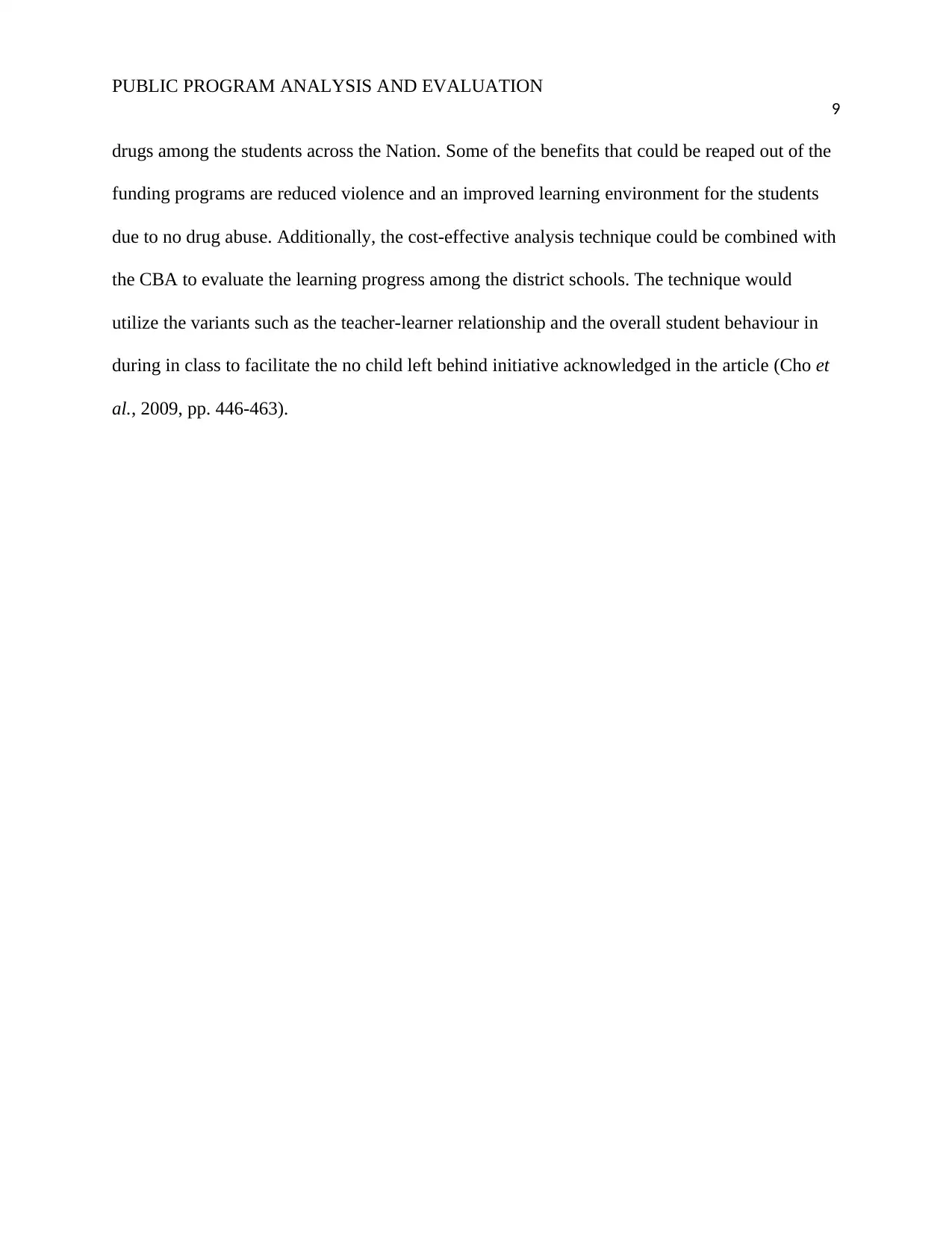
PUBLIC PROGRAM ANALYSIS AND EVALUATION
9
drugs among the students across the Nation. Some of the benefits that could be reaped out of the
funding programs are reduced violence and an improved learning environment for the students
due to no drug abuse. Additionally, the cost-effective analysis technique could be combined with
the CBA to evaluate the learning progress among the district schools. The technique would
utilize the variants such as the teacher-learner relationship and the overall student behaviour in
during in class to facilitate the no child left behind initiative acknowledged in the article (Cho et
al., 2009, pp. 446-463).
9
drugs among the students across the Nation. Some of the benefits that could be reaped out of the
funding programs are reduced violence and an improved learning environment for the students
due to no drug abuse. Additionally, the cost-effective analysis technique could be combined with
the CBA to evaluate the learning progress among the district schools. The technique would
utilize the variants such as the teacher-learner relationship and the overall student behaviour in
during in class to facilitate the no child left behind initiative acknowledged in the article (Cho et
al., 2009, pp. 446-463).
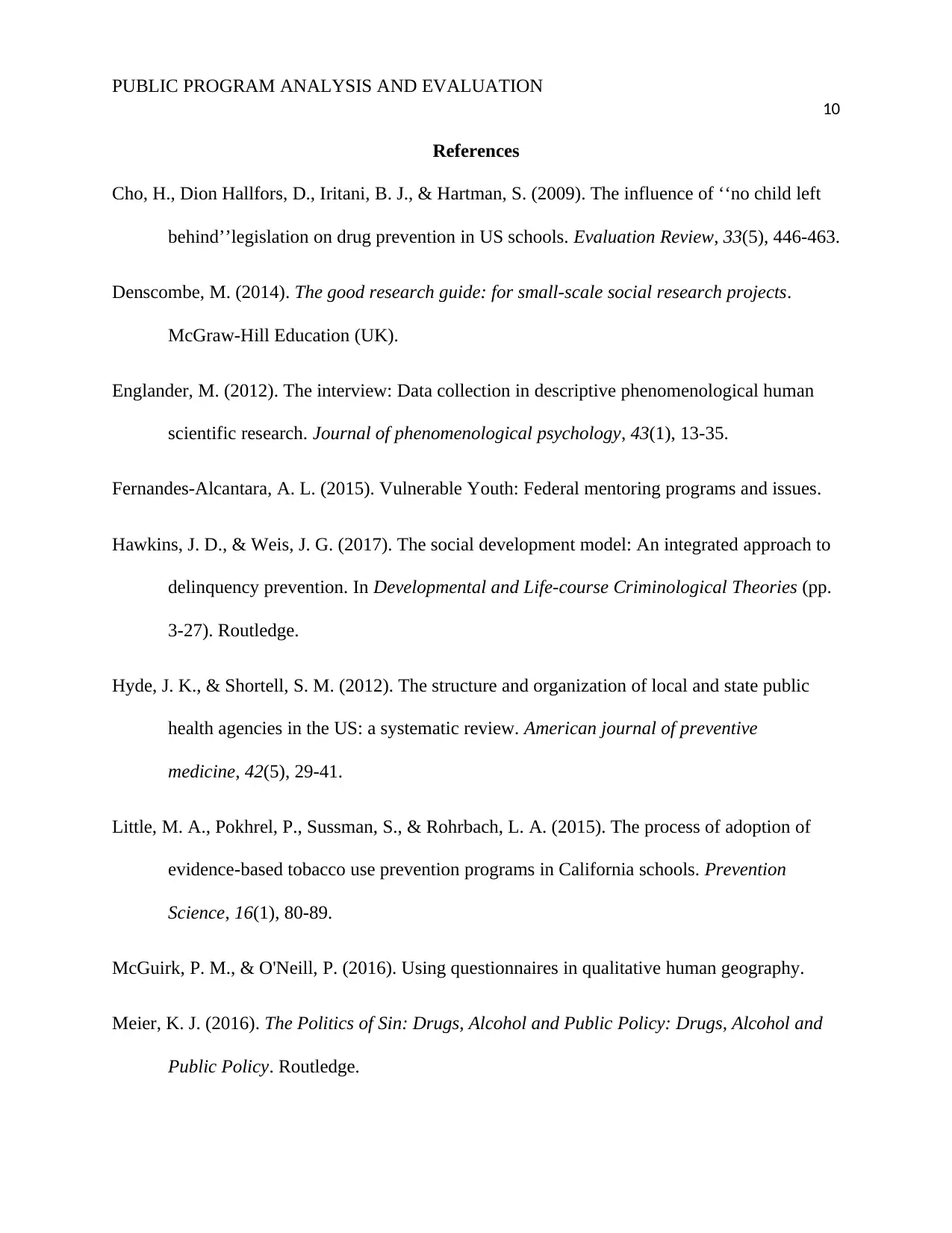
PUBLIC PROGRAM ANALYSIS AND EVALUATION
10
References
Cho, H., Dion Hallfors, D., Iritani, B. J., & Hartman, S. (2009). The influence of ‘‘no child left
behind’’legislation on drug prevention in US schools. Evaluation Review, 33(5), 446-463.
Denscombe, M. (2014). The good research guide: for small-scale social research projects.
McGraw-Hill Education (UK).
Englander, M. (2012). The interview: Data collection in descriptive phenomenological human
scientific research. Journal of phenomenological psychology, 43(1), 13-35.
Fernandes-Alcantara, A. L. (2015). Vulnerable Youth: Federal mentoring programs and issues.
Hawkins, J. D., & Weis, J. G. (2017). The social development model: An integrated approach to
delinquency prevention. In Developmental and Life-course Criminological Theories (pp.
3-27). Routledge.
Hyde, J. K., & Shortell, S. M. (2012). The structure and organization of local and state public
health agencies in the US: a systematic review. American journal of preventive
medicine, 42(5), 29-41.
Little, M. A., Pokhrel, P., Sussman, S., & Rohrbach, L. A. (2015). The process of adoption of
evidence-based tobacco use prevention programs in California schools. Prevention
Science, 16(1), 80-89.
McGuirk, P. M., & O'Neill, P. (2016). Using questionnaires in qualitative human geography.
Meier, K. J. (2016). The Politics of Sin: Drugs, Alcohol and Public Policy: Drugs, Alcohol and
Public Policy. Routledge.
10
References
Cho, H., Dion Hallfors, D., Iritani, B. J., & Hartman, S. (2009). The influence of ‘‘no child left
behind’’legislation on drug prevention in US schools. Evaluation Review, 33(5), 446-463.
Denscombe, M. (2014). The good research guide: for small-scale social research projects.
McGraw-Hill Education (UK).
Englander, M. (2012). The interview: Data collection in descriptive phenomenological human
scientific research. Journal of phenomenological psychology, 43(1), 13-35.
Fernandes-Alcantara, A. L. (2015). Vulnerable Youth: Federal mentoring programs and issues.
Hawkins, J. D., & Weis, J. G. (2017). The social development model: An integrated approach to
delinquency prevention. In Developmental and Life-course Criminological Theories (pp.
3-27). Routledge.
Hyde, J. K., & Shortell, S. M. (2012). The structure and organization of local and state public
health agencies in the US: a systematic review. American journal of preventive
medicine, 42(5), 29-41.
Little, M. A., Pokhrel, P., Sussman, S., & Rohrbach, L. A. (2015). The process of adoption of
evidence-based tobacco use prevention programs in California schools. Prevention
Science, 16(1), 80-89.
McGuirk, P. M., & O'Neill, P. (2016). Using questionnaires in qualitative human geography.
Meier, K. J. (2016). The Politics of Sin: Drugs, Alcohol and Public Policy: Drugs, Alcohol and
Public Policy. Routledge.
Secure Best Marks with AI Grader
Need help grading? Try our AI Grader for instant feedback on your assignments.
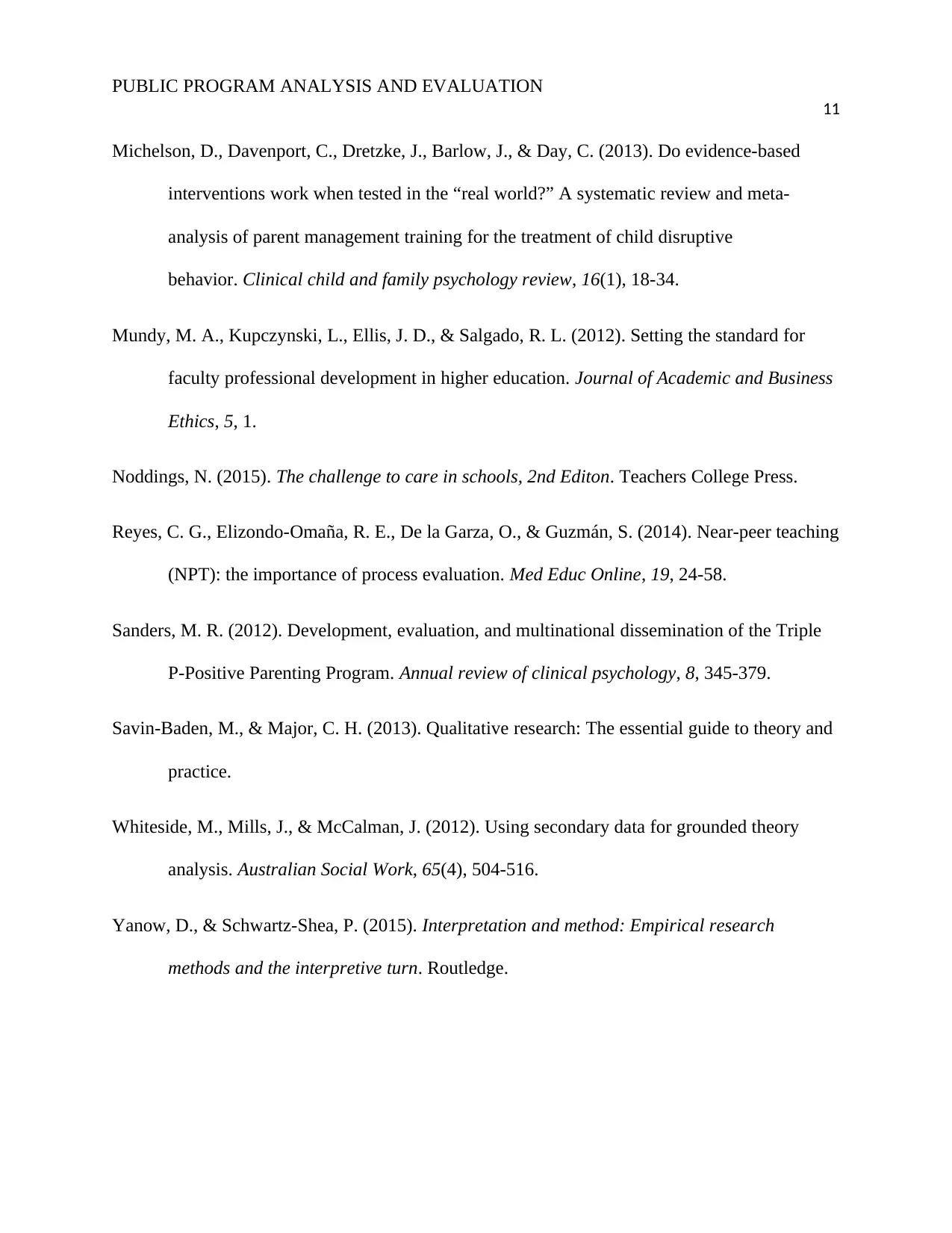
PUBLIC PROGRAM ANALYSIS AND EVALUATION
11
Michelson, D., Davenport, C., Dretzke, J., Barlow, J., & Day, C. (2013). Do evidence-based
interventions work when tested in the “real world?” A systematic review and meta-
analysis of parent management training for the treatment of child disruptive
behavior. Clinical child and family psychology review, 16(1), 18-34.
Mundy, M. A., Kupczynski, L., Ellis, J. D., & Salgado, R. L. (2012). Setting the standard for
faculty professional development in higher education. Journal of Academic and Business
Ethics, 5, 1.
Noddings, N. (2015). The challenge to care in schools, 2nd Editon. Teachers College Press.
Reyes, C. G., Elizondo-Omaña, R. E., De la Garza, O., & Guzmán, S. (2014). Near-peer teaching
(NPT): the importance of process evaluation. Med Educ Online, 19, 24-58.
Sanders, M. R. (2012). Development, evaluation, and multinational dissemination of the Triple
P-Positive Parenting Program. Annual review of clinical psychology, 8, 345-379.
Savin-Baden, M., & Major, C. H. (2013). Qualitative research: The essential guide to theory and
practice.
Whiteside, M., Mills, J., & McCalman, J. (2012). Using secondary data for grounded theory
analysis. Australian Social Work, 65(4), 504-516.
Yanow, D., & Schwartz-Shea, P. (2015). Interpretation and method: Empirical research
methods and the interpretive turn. Routledge.
11
Michelson, D., Davenport, C., Dretzke, J., Barlow, J., & Day, C. (2013). Do evidence-based
interventions work when tested in the “real world?” A systematic review and meta-
analysis of parent management training for the treatment of child disruptive
behavior. Clinical child and family psychology review, 16(1), 18-34.
Mundy, M. A., Kupczynski, L., Ellis, J. D., & Salgado, R. L. (2012). Setting the standard for
faculty professional development in higher education. Journal of Academic and Business
Ethics, 5, 1.
Noddings, N. (2015). The challenge to care in schools, 2nd Editon. Teachers College Press.
Reyes, C. G., Elizondo-Omaña, R. E., De la Garza, O., & Guzmán, S. (2014). Near-peer teaching
(NPT): the importance of process evaluation. Med Educ Online, 19, 24-58.
Sanders, M. R. (2012). Development, evaluation, and multinational dissemination of the Triple
P-Positive Parenting Program. Annual review of clinical psychology, 8, 345-379.
Savin-Baden, M., & Major, C. H. (2013). Qualitative research: The essential guide to theory and
practice.
Whiteside, M., Mills, J., & McCalman, J. (2012). Using secondary data for grounded theory
analysis. Australian Social Work, 65(4), 504-516.
Yanow, D., & Schwartz-Shea, P. (2015). Interpretation and method: Empirical research
methods and the interpretive turn. Routledge.
1 out of 11
Your All-in-One AI-Powered Toolkit for Academic Success.
+13062052269
info@desklib.com
Available 24*7 on WhatsApp / Email
![[object Object]](/_next/static/media/star-bottom.7253800d.svg)
Unlock your academic potential
© 2024 | Zucol Services PVT LTD | All rights reserved.
